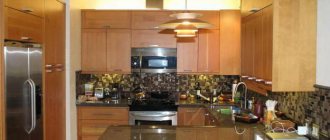Residential vs non-residential: the next step
A little less than a month ago, I read a post about how they want to ban the construction of apartments in Russia. At first I thought: well, another ban, there have been so many of them already. But after some time, this sentence stuck together in my head with some other stories of recent years and forced me to make certain generalizations. After all, apartments are classified as non-residential premises, so why ban them? The treasury is a net benefit: benefits for utility bills do not apply to them, more money can be collected, which means that contributions to the budget also increase. However, they are prohibited... Is it really because in non-residential premises you can choose the purpose of individual parts and use them as you please, like there is too much freedom, while residential premises should be used for the residence of citizens and nothing else!
And then I remembered another action that had already taken place in recent years - the de facto ban on using apartments located in apartment buildings as mini-hotels (I’m omitting the details). After all, hotels are also non-residential premises, although it is not clear why, since they are precisely used for the residence of citizens. It just happened historically that they do not belong to the housing stock, although hostels identical to them do. In Soviet times, the systematic rental of apartments was, at a minimum, not welcomed, and even punishable. Whether the ban on mini-hotels helps replenish the treasury or not is not easy to determine. On the one hand, utilities are provided to them at “preferential” prices, on the other, the systematic rental of premises, as a rule, required appropriate registration and payment of taxes, which the budget loses.
And even earlier, numerous conflicts broke out between the owners and residents of apartments in apartment buildings and restaurants located in the same buildings, which are noisy and open at night, preventing people from sleeping (on Patriki in Moscow, on Rubinshteina in St. Petersburg). The authorities in these conflicts, as a rule, sided with the residents, restricting restaurateurs or completely prohibiting them from operating. The goal was declared to be good - to protect the interests of citizens living in apartment buildings, albeit at the expense of the budget, which was deprived of tax revenues. I’m not sure, however, that the income will be large, because everyone knows how difficult it is to force restaurateurs to pay taxes in full.
It would seem that all three situations can serve as beautiful examples of how state (municipal) bodies and their officials take care of the interests of citizens. Only citizens are unlikely to believe this. Improving the quality of service to the housing stock and reducing fees for housing and utilities would contribute much more to the growth of citizens’ well-being. This is where the maximum effort would have to be made. However, prices in the housing sector are steadily rising, and quality is declining. Ask what the average citizen would choose: expel the restaurant from the first floor of the house or reduce housing payments by two or three times. I think that the majority will be in favor of reducing payments. This means that it is not a matter of caring for the interests of citizens, but something else. What?
I see only one reason here: the manic desire of state (municipal) bodies to limit the freedom of citizens and organizations to use their property. What are apartments? Non-residential premises for free use! Ban! Mini-hotels are also a way to break out of the strict restrictions imposed on residential premises, while increasing income. It is forbidden! The use of premises for restaurants and entertainment venues, subject to the established restrictions, seems to be legal. Organize regular inspections, depriving you of income! Do you want to change the purpose of the premises? But here is an order that cannot be overcome! I won’t even remember about the coronavirus...
We must not forget that the bureaucratic apparatus and citizens with independent sources of income are historical enemies. During periods when the freedom of society is under threat, this apparatus uses any loopholes to infringe on the interests of private owners, both small and large. It’s just that the latter have much more means of protection, although they do not always help. And one of these loopholes, in my opinion, is the rigid division of real estate, primarily premises, into residential and non-residential (Article 288 of the Civil Code). This is undoubtedly a birthmark of the Soviet system, preserved in our civil law. It was once used to prohibit citizens from owning property used for business activities. First, such property was expropriated after 1917, and then they were monitored to ensure that it did not appear in the hands of citizens again.
With the fall of the USSR, the possibility of private individuals owning productive property was legalized, but for some reason the division of real estate into residential and non-residential remained. Being harmless in the 90s of the 20th century, when the degree of freedom was high, this rule made itself felt when the socio-political situation changed in the last decade. The bureaucracy adopted it and used it as a methodological justification for limiting the freedom to use property by private individuals. And as a cover, she began to refer to the idea of protecting the rights of tenants. There is no dispute, the idea is good. But why, while caring for the interests of some, do they infringe on the rights of others, when it would be possible to introduce reasonable regulation on a win-win model. Where is freedom, equality and fraternity?
I will talk about what such regulation might be like later. And so there were too many letters. https://realty.rbc.ru/news/5fb69f9a9a7947470401a256?fbclid=IwAR2e1oXZFWeOjvJb3cKX0B3A25cnMo3gl1ja_zfOS3vAEcmdLilKeS2E9-A
Premises without a separate entrance - a separate property
To begin with, we note that a room is a part of the volume of a building or structure that has a specific purpose (residential, non-residential) and is limited by building structures.
With regard to premises, it is legally established that registration with the state cadastral register is not allowed if:
- the premises are not isolated or separated from other premises in the building or structure (except for parking spaces) (clause 34 of part 1 of Article 26 No. 218-FZ);
- there is a complete or partial coincidence of the location of the premises with the location of another premises, with the exception of the object being converted, as well as a coincidence of the location of the apartment and the room in it (clause 50 of part 1 of Article 26 No. 218-FZ).
The court in its ruling considers the question of whether part of the premises without a separate entrance a separate piece of real estate.
The tenant of a municipal property applied for preemption. However, the administration twice refused to conclude a purchase and sale agreement, citing the fact that it was not possible to privatize this premises, since it was not an independent piece of real estate.
After this, the tenant went to court. The first instance declared the refusal to complete this transaction illegal. The appeal upheld the administration's decision. The rented part of the non-residential premises cannot be purchased on a preferential basis, since it is not formed as a separate real estate object and is not registered in the cadastral register. There is an entrance only through the adjacent room.
The cassation court did not agree with the appeal. The disputed object is separated by building structures, has its own number in the technical passport, and, therefore, is isolated.
“The courts of the first and appellate instances established that the disputed premises are part of a non-residential premises, in accordance with the technical passport of which the specified premises are limited by existing building structures, have an entrance through an adjacent premises, and are indicated on the technical passport with its own number. Thus, the courts established the isolation of the disputed non-residential premises.
In relation to the provisions of Articles 26 and 27 of Law No. 218-FZ, the sign of isolation of the premises is mandatory for the implementation of state cadastral registration and (or) state registration of rights. Meanwhile, the current legislation does not connect the qualification of a property as separate and isolated with the presence of an entrance independent of other premises.
Such a sign of an isolated premises, such as a separate entrance, indicates the possibility of excluding access to the premises by the owners of other premises, that is, the absence of a passage value/function/character for the premises, the possibility of access to other premises without using the premises in question (letter from the Ministry of Economic Development of the Russian Federation dated December 24, 2013 N OG-D23-6667 and N D23i-6062)".
Accordingly, the conclusion of the court of first instance about the illegality of the administration’s refusal to exercise the entrepreneur’s right to privatize the above-mentioned property is lawful.
You can read the full text of the resolution on our website.
Subscribe to our social media channels: Vkontakte, Facebook, Instagram.
Photo: iStock.com
Advertising material was created with the support of the “Center for Entrepreneurship of the Orenburg Region”.
Taxpayer position
The entrepreneur indicates that his commercial activity of selling doors and furniture through the showroom relates to retail trade, and therefore the application of a special UTII tax regime during the audited period is justified. The technical passport indicates the purpose of the premises: two parts - a utility room and a sales area.
In the rented premises, the entrepreneur equipped a room for an office, where there was a table, a computer, catalogs, furniture, samples of fittings, and samples of materials used to order furniture. Another room was used as a sales area, where there were built-in structures with door models. The entrepreneur used this premises as a warehouse. The sale of goods was carried out to individuals for cash payment.
General information
Utility rooms include premises or certain areas of the apartment that are allocated to meet the needs of residents of the household plan.
There are the following types of utility rooms:
- - toilet and bathroom,
- - kitchen,
- - hallway,
- - dressing room,
- - cabinet,
- - garage,
- - library,
- - workshop,
- - boiler room,
- - storage room,
- - veranda,
- - basement room.
In addition to utility rooms in residential buildings, there are auxiliary rooms in industrial buildings or other non-residential buildings. For example, warehouse premises at a retail outlet used for storing products or warehouses located over large areas of the enterprise. The main conditions for normal storage are maintaining a certain temperature, normal ventilation and protection from direct sunlight.
A utility room can be a small niche in an apartment, but if it is a private house or cottage, the utility rooms can occupy a significant area. As a rule, they are located on the ground floor or in the basement; they can be located in separate extensions or free-standing buildings.
Property requirements
The property must meet the following requirements:
- There must be a separate entrance or the ability to arrange one.
- There are certain requirements for the location: on the ground floor or above a non-residential premises.
- It should not be used for permanent residence or interfere with the overall architectural appearance of the house.
- There are no third party rights or any encumbrances.
- Also, it should not form part of the living space. For example, you cannot transfer part of an apartment or room in a communal apartment.
Attention! If such real estate can be used only with the annexation of part of the common space of an apartment building, the consent of the residents will be required. To obtain it, you will need to hold a general meeting.
Permission will also be required to organize a separate entrance if this requires changing the enclosing and/or supporting structures.
Further use must comply with the following requirements :
- sanitary and hygienic;
- fire protection;
- environmental.
In particular, if non-residential premises are located in a residential building, the following cannot be placed in it :
- Enterprises that pollute the territory and air (physically and chemically).
- Violating living conditions.
- Some treatment and preventive organizations (helping with drug and alcohol addiction, infectious patients).
- Industrial enterprises.
- Stores selling chemical, explosive or other dangerous goods.
- Dry cleaners.
- Public toilets.
- Institutions operating later than 11 pm (or, moreover, around the clock).
What relates to buildings, their functional and purpose
The intended purpose of non-residential premises is determined by the activity for which it is intended.
Below is a classification by intended purpose:
- production;
- sports;
- warehouse;
- municipal and household;
- educational;
- trading;
- catering enterprises;
- medical;
- free appointment;
- office
The functional purpose of a building means the presence of design features and technical characteristics that allow it to be used as an independent building.
Based on their functional purpose, buildings are divided into the following groups:
- basic;
- technical;
- communication;
- auxiliary;
- serving.
What objects belong to this category of buildings and structures?
Such real estate is divided into:
- main;
- and auxiliary.
The first can be used separately, and the second is needed for maintenance and use of other premises. For example, a school office is the main room, and the corridor is an auxiliary room.
also a division according to intended purpose . In accordance with it, premises can be:
- Educational (these include buildings of kindergartens, schools, universities, etc.).
- Healthcare (for example, hospitals, clinics, emergency rooms).
- Industrial.
- Administrative.
- Utilities (gas, water, electricity, heat supply).
- Catering.
- Household services (these include studios, laundries, dry cleaners, repair shops and others).
- Trade.
- Relaxation and entertainment.
- Post offices (post offices).
- Warehouse.
- Creative (workshops and exhibition halls).
Differences from premises for permanent residence
The main difference is the purpose. Residential premises are intended for living, and non-residential premises are intended for other purposes. This could be trade, provision of services, production, etc.
An additional feature will be the presence (or absence) of a separate entrance. The location on the floor in an apartment building is also important.
Examples of what belongs to the residential stock and what to non-residential. The residential stock includes :
- apartments of an apartment building, including communal ones;
- separate houses intended for permanent residence;
- dormitories.
Classified as non-residential:
- the shops;
- dry cleaners;
- Beauty Salons;
- hotels (since they are intended for temporary residence, not permanent);
- apartments.
So, non-residential premises include separate premises not intended for living. They can be of different types according to their purpose and used for different purposes, and must also meet a number of requirements.
Auxiliary and main
Reference! An auxiliary object is considered to be an object used for operation or consumer services (lobby, pantry, staircase, corridor).
The main premises are those in which functional processes are carried out. This includes premises, auditoriums and classes in government institutions, offices, chambers. There are also public premises, namely cinemas, theaters, halls in museums, clubs, assembly and reading rooms, administrative offices, and shopping areas.









